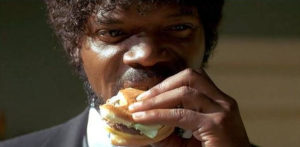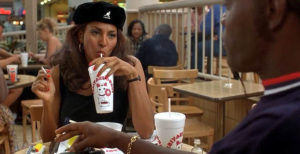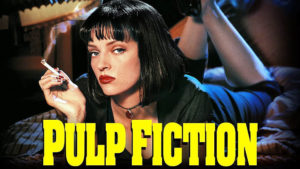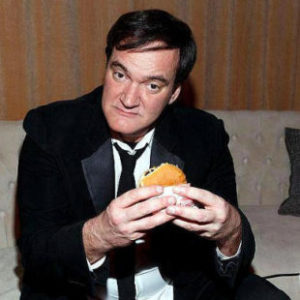Quentin Tarantino e il rapporto con il cibo nei suoi film.
è un articolo di Mimmo Farina – Gastrodelirio – gastrodelirio.it
Il rapporto tra cinema e cibo è un rapporto viscerale.
Essendo il cibo una delle attività fondamentali dell’essere umano, è ovvio che anche la settima arte se ne occupi.
Ho trovato interessante, poi, il rapporto col cibo che ha uno dei registi postmoderni più discussi, l’italo-americano Quentin Tarantino.
Tarantino, a parere del vostro umile scrivente, è un eccellente dialoghista, un bravo citazionista, ma anche un po’ copione e sadico inespresso.
Nessun desiderio polemico, ha amato e mi sono divertito con diversi lavori di questo discolo ragazzaccio, così come non me ne sono piaciuti altri.
In parecchi dei suoi film, comunque, si trovano riferimenti al cibo, spesso in chiave pop, altre volte in chiave, se si può dire, più velata e raffinata.
Il primo pensiero va al Royale con formaggio di Pulp Fiction.
All’interno di una articolata discussione sulle stranezze europee, partendo dal sistema metrico decimale per finire all’abuso di maionese, si inserisce la diversità dei nomi di alcuni panini della “doppia M” al di qua ed al di là dell’Atlantico.
Così quello che è il “Quarter Pounder deluxe” (nome attualmente in voga anche in Italia) diventa il “Royale con formaggio”, in omaggio alla impermeabilità francese ai neologismi britannici.
Tutti dettagli che vengono sommersi dalle truci vicende dei due personaggi incarnati da John Travolta e Samuel L. Jackson, ma che passano e poi tornano alla memoria quando si rievoca la pellicola.
Ma spessissimo lo Junk Food fa capolino nelle scene dell’ex commesso di videoteca.
In “Reservoir Dogs” (in Italiano le Iene), patatine, hamburger e superalcoolici sono compagni inseparabili delle vicende dei protagonisti.
Nel successivo “Jackie Brown”, è del pollo al sugo con cipolle, insieme a fagioli in umido e riso saltato con pisellini (!) la molla che fa chiudere Chris Tucker nel bagagliaio dell’auto.
Anche qui i superalcolici la fanno da padrone, insieme agli immancabili caffè e birra.
Kill Bill (soprattutto il Volume 1), è un trionfo di sushi, abbinato ad un clamoroso errore dei doppiatori italiani.
Mentre la temibile Gogo Yubari (Chiaki Kuryama) sta ubriacandosi un amico le chiede se le piaccia “la” Ferrari.
In realtà si parla del famoso spumante trentino che la killer nipponica sta tracannando dalla bottiglia, mentre il dialogo è stato interpretato come se ci riferisse alla leggendaria marca di Maranello (peraltro assolutamente fuori contesto nella scena).
Comunque, alla baby killer orientale il Ferrari non piace (de gustibus…).
Sempre a proposito di cibi discutibili, Uma Thurman vede Bill (David Carradine) preparare un toast con sottilette, salumi, maionese e pomodori e ancora non lo uccide.
Nello split film “Kill Bill” la fanno da padrone anche alcune specialità tex-mex, come i nachos di cui si ingozza Kurt Russell.
Il tutto, ovviamente, innaffiato da quantità industriali di superalcolici.
Non c’è che dire, una dieta salutista!
A proposito di salutismo, per il gioco dei contrasti (probabilmente) in “Bastardi senza gloria” il fetentissimo nazista Hans Landa (Christoph Waltz) al vino preferisce il latte ed è goloso di dolci.
Per la precisione, in una scena davvero ben congegnata, si gusta uno strudel, mentre la sua vittima designata viene invitata a mangiarne uno con panna.
Come non mangiare fagioli in un western?
Nemmeno Quentin può sfuggire a questa regola non scritta e così, in “Django Unchained” si omaggia la tradizione di Bud Spencer e Terence Hill, con i famosi dicotiledoni stufati ed accompagnati da del gustoso e semplice pane.
Si può ben dire che la caratteristica ricorrente della presenza del cibo nei film di Tarantino è legata alla quotidianità, senza dare apparente risalto alle pietanze ma, per contrasto, rendendole protagoniste mettendole sullo sfondo.
Indubbiamente però, i film di Tarantino, anche dal punto di vista alimentare, sono tutt’altro che di facile digestione e complementari alle vicende narrate sullo schermo.
Altrettanto indubbiamente non è il tocco delicato quello che si può trovare, ma se si è fan del regista di Knoxville questo è fatto notorio…





